Nyoninmichi Hiking
Koya Sanzan Route and Women Pilgrimage Route 女人道ハイキング 高野三山めぐり
Start: Nyonin-do → Dake Benzaiten → Koyasan Daimon → Nakanohashi Parking
Lot → Koyasan Sanzan → Goal Nyonin-do
Hike along the Nyonin-do trail, visiting the remains of the Koyasan Nanakuchi Nyonin-do and the Koyasan Sanzan,
distance: approx. 16km, approx. 8 hours
The Women`s Pilgrimage Route or Nyonin-michi is the route female pilgrims
once used to circumnavigate Koyasan, the sacred plateau.
Women were not allowed to enter into Koya town before 1872.
The nyonin-michi routes came into heavy use during the Edo period (1603-1868) when these mountains paths functioned primarily as pilgrimage route and access points for Koyasan.
Seven official "gates" along the Nyonin-michi functioned as entraces
to Koya town at various places along the trail..
Fudozakaguchi ![]()
Fudozakaguchi is located at Mt. Koya in Wakayama Prefecture.
The entrances to the sacred area of Mt. Koya are known as the "Seven Entrances to Koya," and Fudozakaguchi is one of them.
The Kii Kuni Meisho Zue describes it as one of the seven climbing routes as follows:
The Seven Entrances to the Mountain: All seven entrances have a women's
hall. Women are not allowed to enter above the hall.
Fudozakaguchi is also called the Kyoguchi. It is located in Isshin'in Valley.
It meets those who enter from the Daimonguchi entrance in Odawara Valley.
It is 50 cho (5.4 km) to Kamiyatsuji.
This is the northern entrance to the mountain, and those coming over Kiimi
Pass from Kyo-Osaka and those coming over Matsuchi Pass from Yamatoji meet
at Nikkenchaya in Shimizu Village, and 90% of the pilgrimage people make
their pilgrimage from this road via the Gakubunji route.

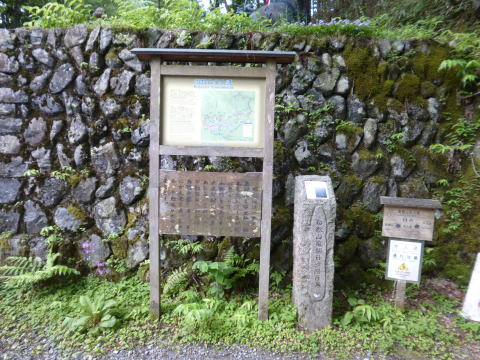
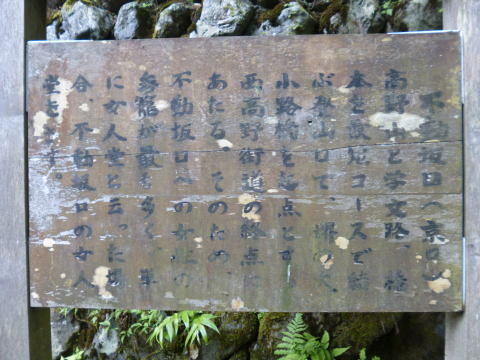
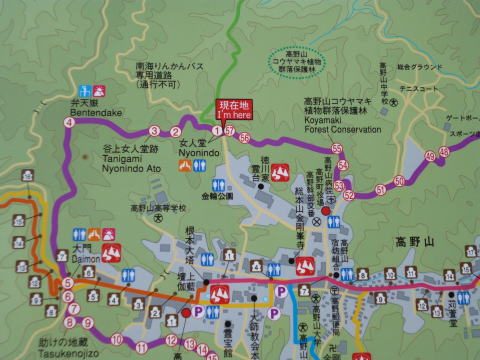
![]()
Nyonindo is located at the Fudo Slope Entrance of the Koyasan in Wakayama
prifecture.
Koyasan has been the strict buddhist training ground.
Therefore women were not allowed to enter Koyasan before 1872.
Originally there were seven different mountain trails leading to Koyasan
from below.
There were seven residences for women pilgims at each of seven entrances.
Those seven women residences were called Nyonindo.
Now there is only one remaining at the Fudo Slope Entrance.
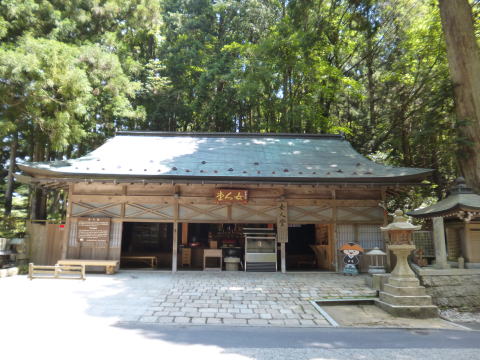
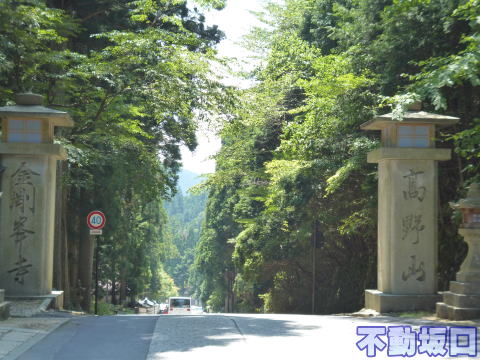
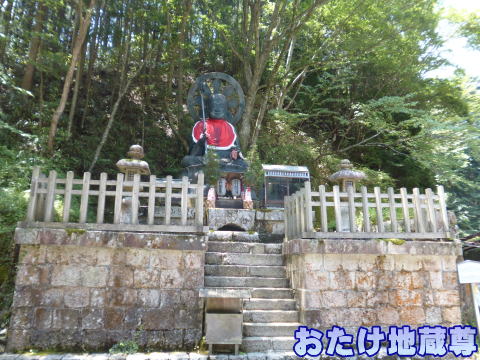
Nyonin-do (“Kii meisho Zue” guide book in
18th century)
This is a facility for women who visit Mt.
Koya from various countries to stay. There is a Nyonin-do at each of the seven
entrances to Mt. Koya, but this hall is said to be the largest. Women have been
forbidden to enter the central area of ??Mt. Koya since
ancient times. We do not go into detail about the reason, but touch on it
briefly.
Kukai (Kobo Daishi) never hated women. His
teachings teach that "women are the origin of people, and they are the
ones who spread the family line and inherit the family."
However, when men and women get too close,
they can be drawn to each other by desire. Therefore, no matter how hard a
disciple trains, there is a possibility that he will make an unexpected
mistake. For this reason, the teaching has been passed down that "too
closeness is the cause of many evil deeds."
In addition, an order from Emperor K?nin
also prohibited men from entering nunneries and women from approaching
monasteries. This is due to a deep thought to cut off delusions and desires,
and we should understand its meaning.
If a devout woman were to stay in this Nyonin-do
hall for one night, bow down to the temple buildings (such as the main Garan
Temple complex) and pray from there, and if she were to make some kind of
merit, no matter how small, with all her heart, she would be able to escape
from a world of long delusion and enter a world of eternal enlightenment.
Kosugi Myojin Shrine ![]()
Kosugi Myojin Shrine is a small shrine (Jizo Hall) located on the grounds
of the Women's Hall at Mount Koya in Wakayama Prefecture.
During the Bun'ei era (1264-74), there was a beautiful young woman named Kosugi at Kinokuniya, the main inn in Echigo Province.
One day, a folding screen with a poem written by Kosugi herself, "Today I am here, tomorrow I do not know where I will go, I have neglected myself," caught the eye of Uematsu Chikamasa, the magistrate of Izumozaki in Mishima County, and through this connection she was to marry his heir, Nobufusa, but due to a scheme by her stepmother, she was suspected of infidelity.
The strict Chikamasa said, "I cannot apologize to my lord," so he took Kosugi to Hatoga-mine Peak, cut off the fingers of both her hands, and threw her into the valley.
Her life was saved by the protection of Kobo Daishi, and while living with bears in the mountains, she met Nobufusa again, married him, and had a child.
Later, her stepmother interfered again, and she was separated from her husband. Not only was she attacked in the mountains of Shinshu, but her child, Sugimatsu, was killed.
She came to Koyasan with Sugimatsu's hair, but was not allowed to enter the mountain as women were not allowed to enter.
With money she had saved for her child, Kosugi built a seclusion hall for
women at the entrance to Fudosaka in Koyasan, and began to entertain women
who came to make pilgrimages.
This is said to be the beginning of the Women's Hall at Koyasan. Kosugi Myojin Shrine was built in the Edo period, and enshrines Kosugi as the guardian deity of the Women's Hall.
Take the Nankai Rinkai Bus from Koyasan Station on the Nankai Koya Line and get off at the "Women's Hall" stop. There are several parking spaces on the west side of the Women's Hall.

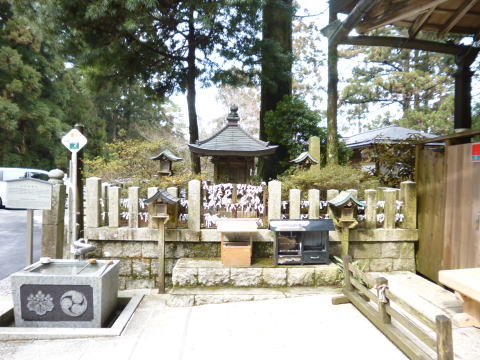
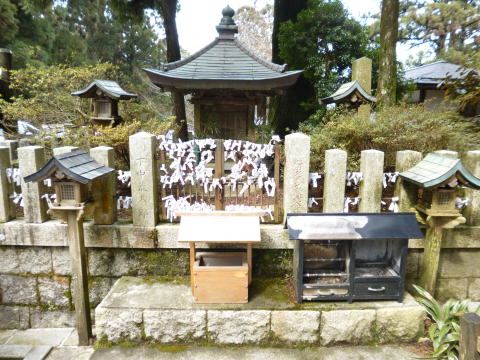
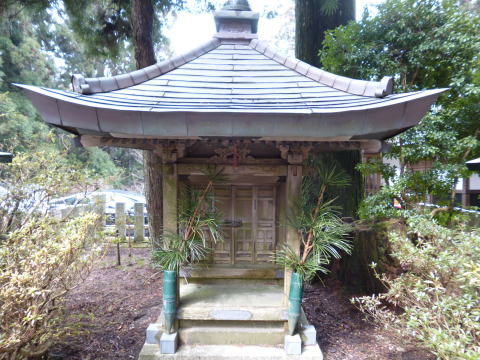
Koyasan Koyamaki Rare Protected Fores ![]()
The Koyasan Koyamaki Rare Protected Forest is located near the Nyonin-do
Hall of Mt. Koya in Wakayama Prefecture.
The information board in front of the Nyonin-do Hall reads:
Koyamaki Protected Forest
Koyamaki was widely distributed all over the world in ancient times, but
it has become almost extinct by approximately 10,000 years ago and grows
only in Japan and part of Korea (Jeju) now.
Particularly, such large scale of pure Koyamaki forest can be found only
here in Koyasan throughout the world.
Koyamaki: Japanese umbrella pine, Scientific name : Sciadopitys verticillata
Wakayama District Forest Office, Foresry Agency
It takes about 20 minutes from Nyonindo Women's hall through the walking
trail.
In the grounds of Kongobu-ji Temple, there is a Koyamaki tree planted to commemorate the visit of the Emperor and Empress.
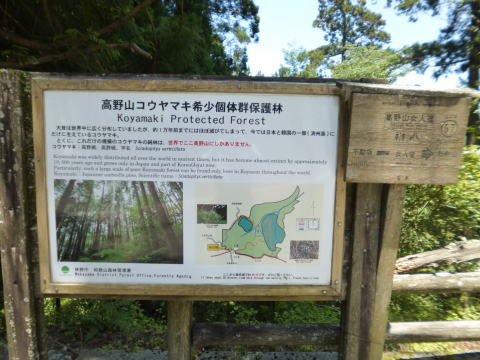
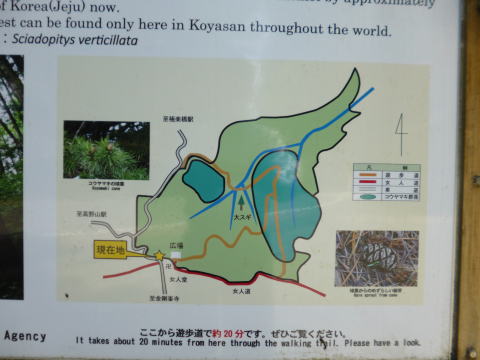
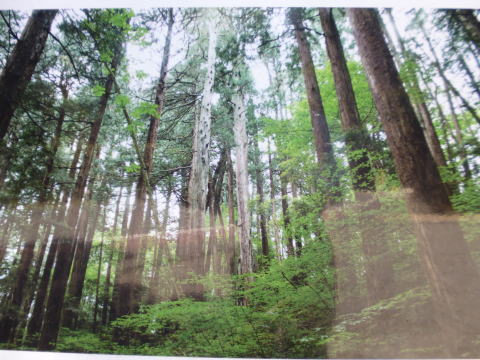
remains of the Tanigami Women's Hall ![]()
The remains of the Tanigami Women's Hall is located on the Women Pilgrimage
Route at Mount Koya in Wakayama Prefecture.
This is the location of the women's halls on the Ouzu Road and Hanasaka
Road of the Koyasan pilgrimage routes.
The Kii Meisho Zue Illustrated Guide states the following:
Tanigami: Located directly north of Danjo Garan. To the east it continues
into Honchuin Valley.
Tanigami: Can be seen below the line of Ichinotaki waterfalls.
This is the road leading from Danjo to Dakebenten.
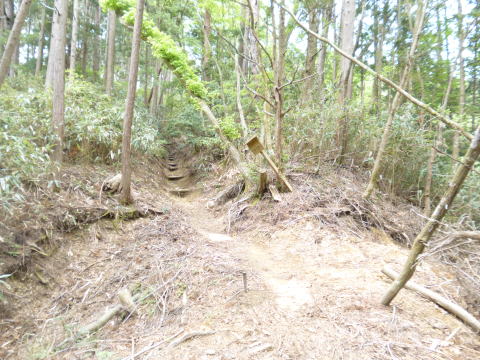
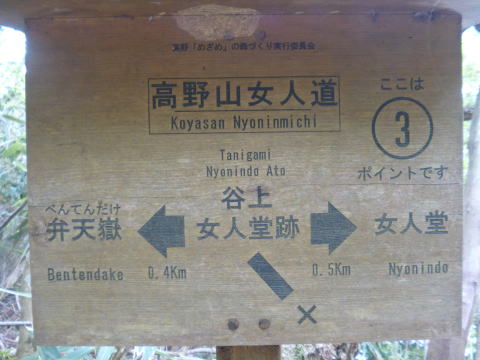
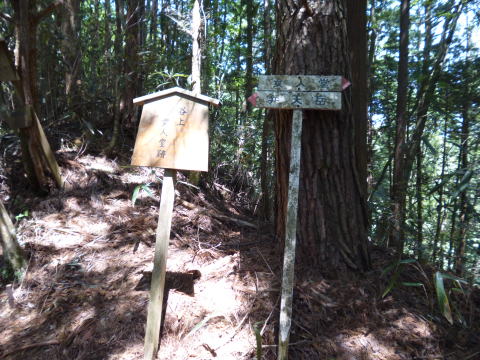
Dake Benzaiten![]()
Dake Benzaiten is one of the Seven Benten at Mount Koya in Wakayama Prefecture.
She is enshrined at the summit of Mount Benten, one of the mountains known as the Outer Eight Leaves of Mount Koya.
The trailhead is on the north side of Mount Koya's Daimon Gate, and if you follow the line of torii gates along the Women's Path, you will arrive at the summit of Mount Benten (984.5m above sea level) in about 30 minutes.
From among the cedar trees along the Women pilgrimage Route, there is a
place where you can look down on the Konpon Daito Pagoda, and it is said
that women who made pilgrimages to Mount Koya would once pray from the
Women Pilgrimage Route.
The Kii Shoku Fudoki records it as follows:
It is said that the Great Master (Kukai) buried a jewel on this mountain for the Buddhist priest, placed a treasure jar there and invited a heavenly maiden to worship.
After that, a Tengu named Myoonbo always protected the place.
Take the bus from Koyasan Station on the Nankai Koya Line to Daimonmae
stop, then walk for 30 minutes.
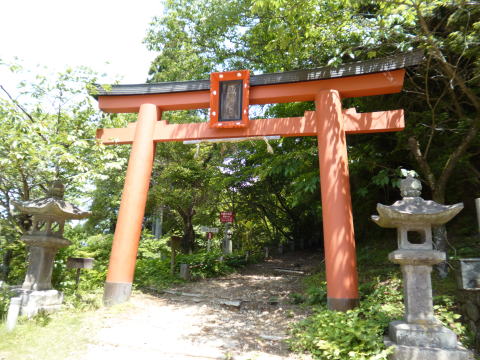
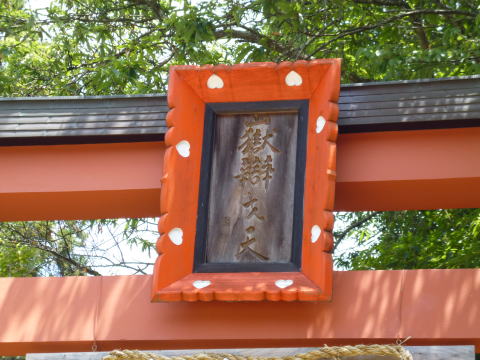
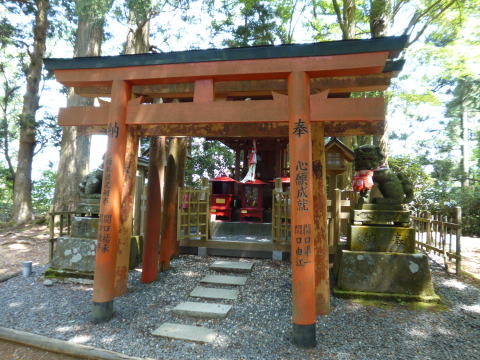
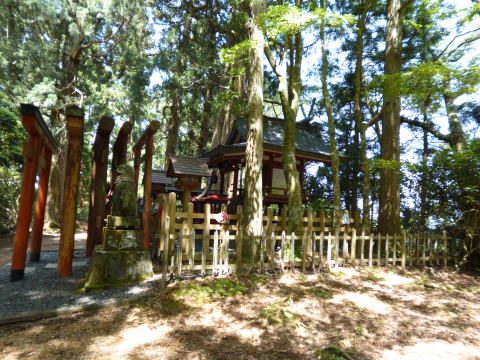

![]()
![]()
Great Gate Daimon is the main gate of the
holy Koya mountain in Wakayama prefecture.
Originally a torii gate in Tsuzura valley used to be the main entrance
when Kukai (Kobo Daishi) founded his monastery.
The ruins of that torii gate, called Ancient Daimon(Kodaimon), can be found 400-500m down from the present site.
Daimon gate was constructed in 1140, but it
has been destroyed several times. The present gate was rebuilt in 1705 and is
25.1m high.
On both side of the gate, statues of
protector deities watch over the entrance of the Koyasan.
On the central pillars of the gate, there
are couplet plates.
The source of the couplet words is the
sentence written by Jogaku, the archbishop of the Toji temple in the 11th
century.
It means that although Kobodaishi remains in eternal meditation at Okunoin, he appears at the place of close connection everyday and pray for the
liberation of all beings.
On the clear days, visitors can glimpse
distant Awaji island and the Inland sea in the west.
The view of the sunset here is spectacular
and selected one of the best 100 in Japan.
It is registered as a National Important
Cultural Asset.
The gate is illuminated at night.
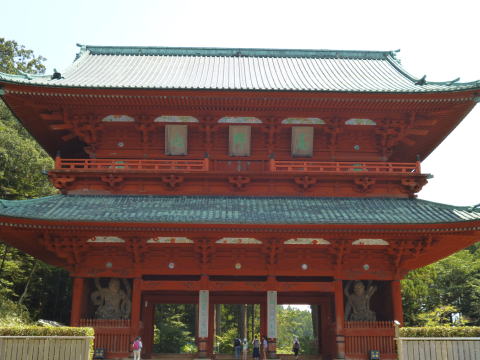
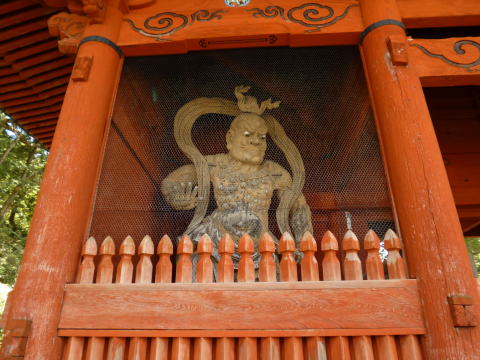
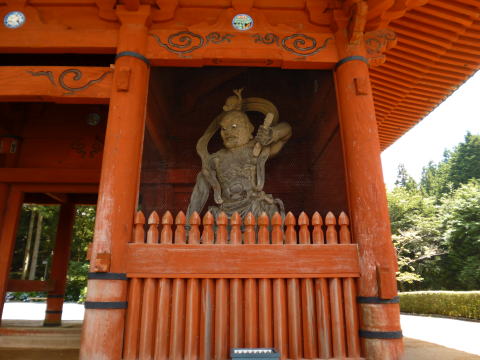

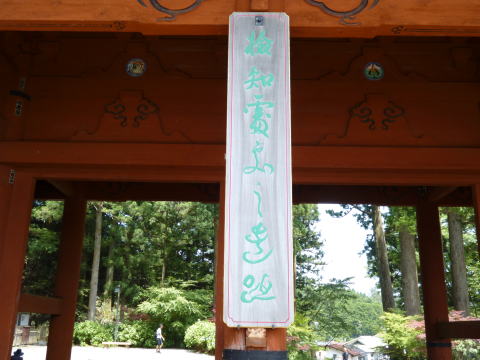
The stone monument of Tamura Mokkoku's haiku ![]()
The stone monument of Tamura Mokkoku's haiku is located in the southern
corner of Koyasan Daimon Square in Wakayama Prefecture.
The following is engraved on the monument:
Leaving the mountain gate, the valley is deep in the autumn sun.
Looking west from Koyasan Daimon, you can see the Katsuragi and Izumi mountains beyond Naruko Valley.
The sun setting is particularly beautiful in the autumn evenings, and many pilgrims gaze upon it quietly.
Mokkoku (1889-1964), whose real name was Shozo Tamura, was active as a
newspaper reporter and haiku poet.
He is known for his contributions to the establishment of the National Spring and Summer High School Baseball Tournaments (formerly known as junior high schools).
Tamura Mokkoku was born on January 1, 1889, as the eldest son of Bunjiro, who ran a temple school, at Kasada Junior High School in Katsuragi Town, Wakayama.
At the age of two, he moved to Osaka when his father got a job, and he went on to Kitano Junior High School and then to Sanko High School, before dropping out.
He joined the Osaka Asahi Shimbun Company in 1910, and while working in
the social affairs department he came up with the idea for the National
Junior High School Baseball Championship Tournament.
The first tournament was held at Toyonaka Stadium on August 18, 1915.
He moved to the Osaka Mainichi Shimbun Company in 1933, where he served as head of the editorial department and advisor to the arts and culture department.
In haiku, he became a student of Takahama Kyoshi in 1917, and was active in the magazine "Sazanka," which was first published in 1922.
In 1946 he founded and presided over the haiku magazine of the same name, Sazanka, until his death in 1964 at the age of 76.
He is said to have participated as a judge in the Koyasan haiku competition, held every summer, 37 times.
He published collections of haiku such as "Autumn Suburb," "Great Moonlit Night," and "Mountain Climbing."
The back of the haiku monument is engraved with the words "July 21st, 1957, Kongobuji Head Temple."
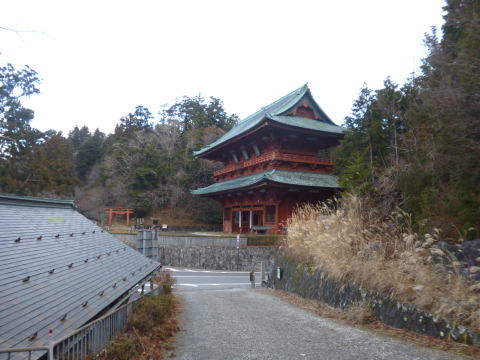
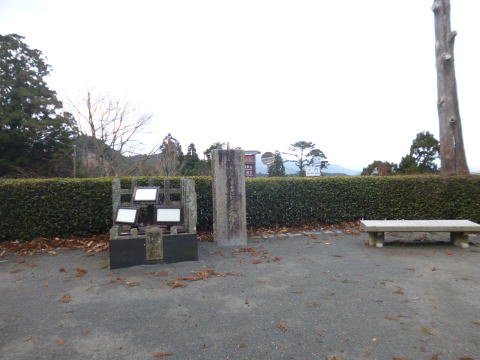
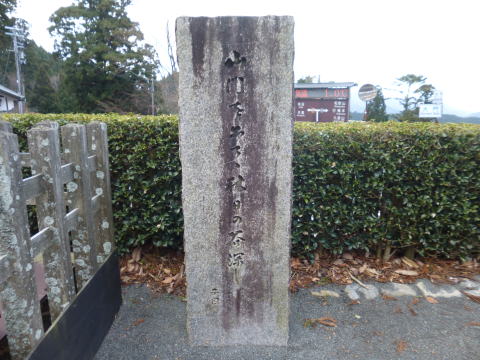
Ryujinguchi (Ryujinguchi ruins) ![]()
Ryujinguchi (Ryujinguchi ruins) is located on the south side of the Daimon
gate of Mount Koya in Wakayama Prefecture.
The entrances to the sacred area of Mount Koya are called the "Seven Entrances to Koya," and Ryujinguchi is one of them.
The Kii Kuni Meisho Zue describes it as one of the seven climbing routes as follows:
All seven entrances have a women's hall. Women are not allowed above the hall.
(Omitted)
Ryujinguchi is also called Yukawaguchi, Yasudaguchi, or Yanaseguchi.
Leads to the left of Daimon. About 13 ri (52 km) from Ryujin.
This road is the entrance towards Hitsujisaru (south west),
if coming from Ryujin in Hidaka county, or Yama Hota in Arita county,
it joins at Shinmura and enters Daimon.
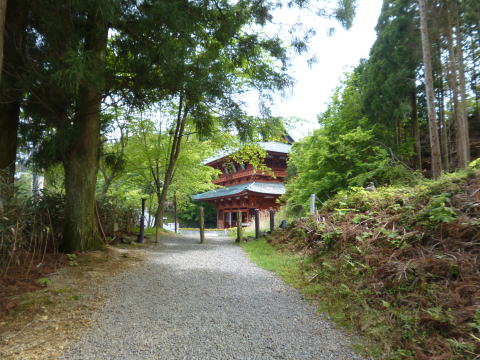

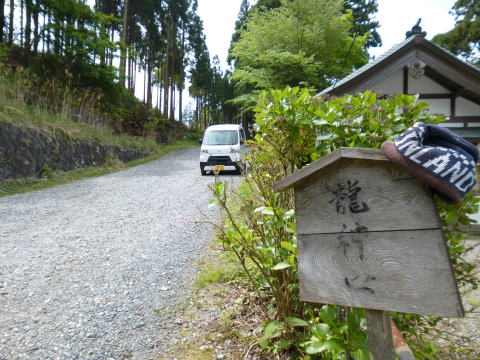

Otasuke Jizo ![]()
Otasuke Jizo is a Jizo statue located in Koya-cho, Wakayama Prefecture,
and is also known as "Help Jizo."
The shrine was built near Ryujin-guchi, one of the seven entrances to Koya,
facing the women prigrimage route, on the south side of Koyasan Great Gate
Daimon.
According to legend, an old man who lived on Mount Koya was walking along a Kumano intersection when he heard a voice calling for help.
He searched in the direction of the voice and found the Jizo statue lying in a small valley by the roadside, so he pulled it up to the road and placed it there.
However, since it was a lonely place with few people, he carried the Jizo statue back to Mount Koya and built a shrine near Ryujin-guchi.
He continued to pray to the Jizo statue every day, and it is said that the Jizo statue began to grant everyone's wishes one by one.
It is also said that the Jizo statue will only listen to one wish in your
lifetime, and that it is good to offer a round-shape object as a thank-you
gift.
Take the Nankai Rinkai bus from Koyasan Station on the Nankai Koya Line, get off at Daimon, and walk for 5 minutes. There is a parking lot on the west side across the road.
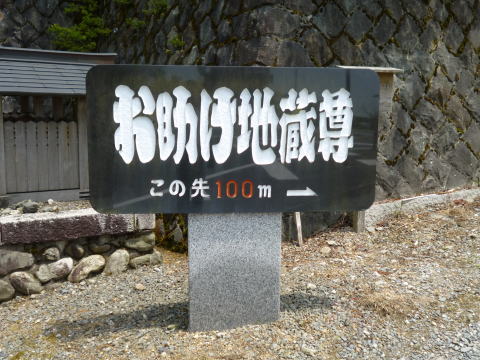
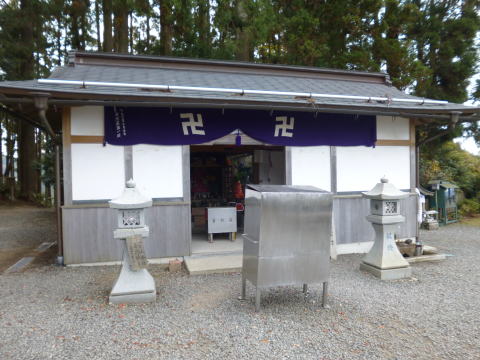
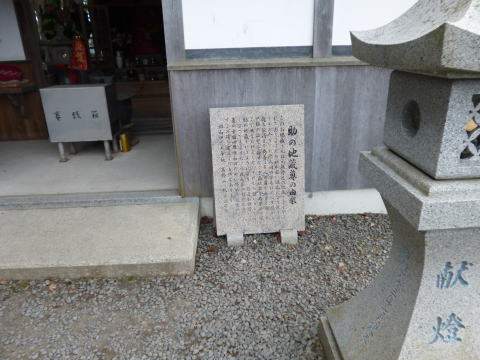
Ainoura-michi pilgrimage route ![]()
Ainoura-michi is one of the pilgrimage routes to Mount Koya, and is located
in Koya town, Ito-gun, Wakayama Prefecture.
The Ainoura-michi runs from Ainoura village to the east of Naigoyama, through Kasamatsu Pass, and to the Ainoura entrance to Mount Koya's southern valley.
The mountain road that continues from Ainoura to the mountains of the Kii Mountains joins the Kumano-michi via Otaki to the east, and the Ryujin-michi via Hanazono Atarashi to the south.
The former Ainoura branch of Koyasan Elementary School is located north of Ainoura village, and Nyu Shrine is located next to it.
In the section on Sakuma Nobumori's former residence in the Kii Mesho Zue
( Illustrated Guide Book), it is written that Sakuma Nobumori, a senior
vassal of Oda Nobunaga, was expelled from Tennoji Castle, passed through
Mount Koya, and settled in a village called Aigo.
It depicts an envoy delivering money from Toyotomi Hideyoshi to help Nobumori
out of his financial difficulties.
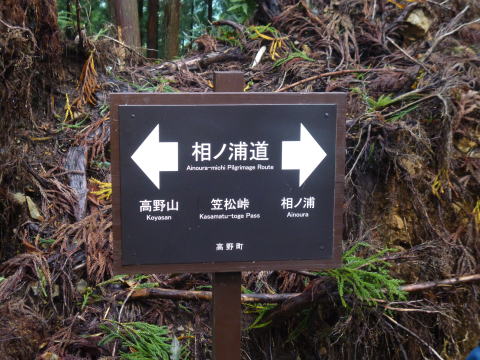
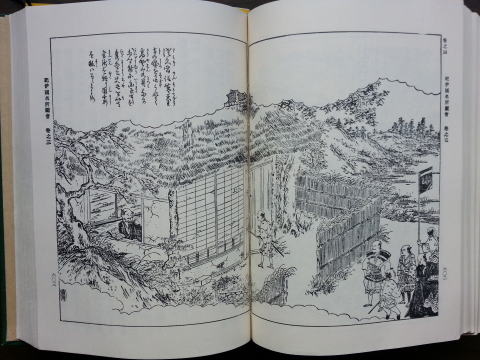
remains of a women's hall at Ainouraguchi ![]()
This is the remains of a women's hall that was located at Ainouraguchi,
one of the seven entrances to Koyasan.
Ainouraguchi is the intersection of the Ainoura Road Route, which runs
from Ryujin and Arita to Mount Koya via Ainoura, the growing area of Japanese
cedar, and the Women's Road Route.
The following is written in the "Sobunho-maki no Juuni Minami-dani" section of the Kii Zoku Fudoki.
The Women's Hall is also called the Yama-no-do.
The main image is Jizo Bodhisattva, made by the Great Master (Kukai), and
is one of the six Jizo in Minami-dani.
It is located about five cho (540 m) south of Rokuji-no-tsuji, and women
who come to worship here stay here.
It is one of the seven entrances to the mountain, and is called the Ainouraguchi.
There is a sign to get off at the entrance. It is about 1 ri 11 cho (5.2
km) to Hanazono-sho Ainoura Village.
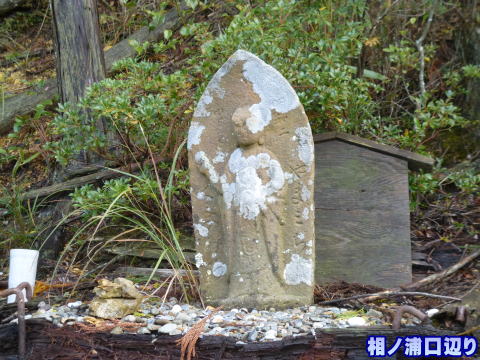
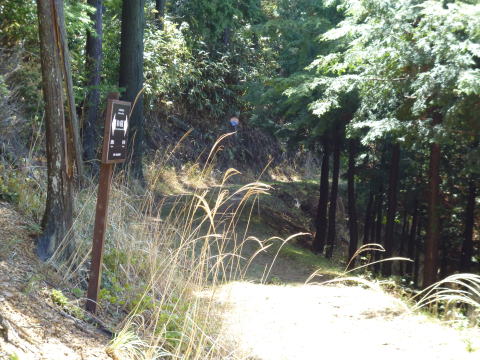
remains of the Otakiguchi Women's Hall ![]()
The remains of the Otakiguchi Women's Hall are located in Koya town, Wakayama
Prefecture.
The seven pilgrimage routes to Mount Koya are called the Seven Entrances of Koya, and until the ban on women was lifted, women were not allowed to enter the mountain from there, and at each entrance a women's hall was built as a secluded hall for women.
The roads connecting these women's halls remain today as the "Women's Roads" that women walked at the time.
The remains of the Otakiguchi Women's Hall are the remains of a women's hall at Otakiguchi, one of the Seven Entrances of Koya.
It is the starting point of the Kohechi, one of the Kumano pilgrimage routes, and connects Mount Koya to Kumano via Otaki.
The Kii Meisho Zue Illustrated Guide states the following:
The Seven Mountain Climbing Routes: All seven entrances have women's halls. Women are prohibited from entering above the hall. (Omitted)
Otakiguchi: Also called Kumanoguchi. Leads to Odawara Valley. This road
is the southeast entrance to the mountain. A pilgrimage route to Kumano
Hongu Shrine, people traveled through deep, secluded mountains and valleys,
approximately fifteen ri (60 km) to reach Koyasan.
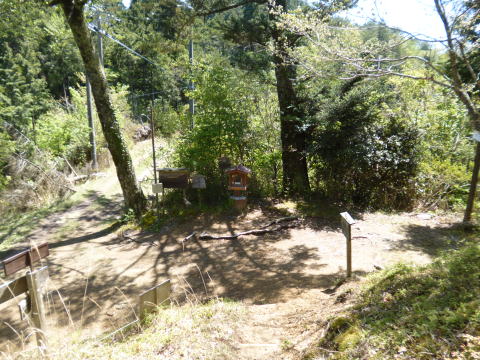
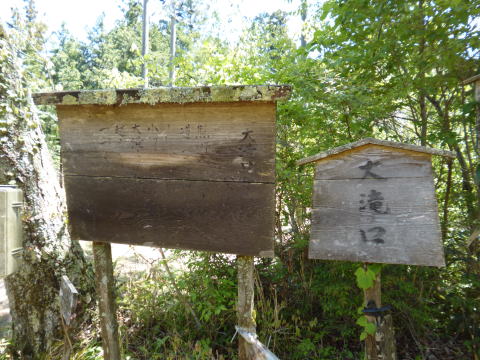
Rokuro Pass ![]()
Rokuro Pass was the location of the Otakiguchi Women's Hall, and is said
to have been named after the women who would crane their necks to look
at Mount Koya from the pass during the time when women were not allowed
to enter.
The Kii Shoku Fudoki guide book records it as follows:
Rokuro Pass: There is a call to descend.
It is about 10 cho ( 1 km ) southeast from Rokujikane-no-tsuji, and is
one of the seven entrances to the mountain.
It is a pilgrimage route to Kumano, and is about one ri from Otaki Village.

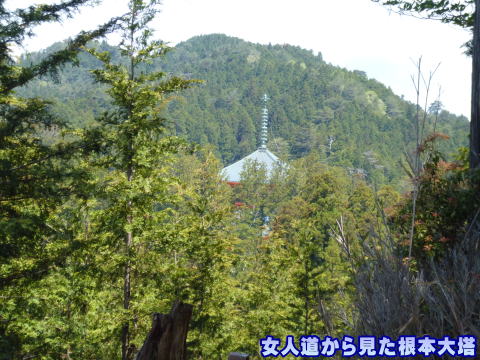
Shin Bessho Entsu-Ritsumei-ji Temple![]()
Entsu-Ritsumei-ji Temple is located in a tranquil valley, one mountain
south of Renge Valley in Mount Koya, Wakayama Prefecture.
It consists of buildings such as the main hall, priest's quarters (kuri), bell tower gate, treasure house, guardian shrine, and dormitory.
It is called Reigakusan Ritsuzo-in Temple, and its principal image is Shaka Nyorai (a wooden seated statue, a nationally designated Important Cultural Property).
In the past, it was called Senjuojo-in Temple, and was also called Shin
Bessho (Shinbessho) in contrast to Odawara Bessho, which was founded by
Kyokai, Naka Bessho, which was inherited by followers of Kakuban, and Higashi
Bessho, which was founded by Myohen, among the Bessho temples of Mount
Koya.
A Bessho is a place where nembutsu saints gather.
It is said to have been founded by Chisen Daitoku, one of Kukai's ten greatest
disciples, and fell into ruin after Chisen's death, but was rebuilt by
Shunjobo Chogen, who served as the chief monk for the rebuilding of Todaiji
Temple in Nara during the Bunji era (1185-89), and used as a training center
for exclusive nembutsu.
At the time, it is said that Genku, Kumagai Renshobo, and others climbed the mountain and formed a friendly relationship with Chogen.
The temple later fell into decline when Chogen moved to Kamakura in response to an invitation from Minamoto no Yoritomo, but in 1612 during the Edo period, Yamaguchi Shuri-no-jo Nyudo Shigemasa (who shaved his head and was known as "Shinkei"), who served the second shogun Tokugawa Hidetada, tried to revive it together with Genshun, admiring Chogen's work.
It was rebuilt in 1619, and Kenshunbo Yoshinaga was invited to revive it.
Since then, it has been passed down to the present day by abbots with strict
discipline, such as Shinseibo Ennin, Eshinbo Myozui, Mitsumonbo Honsho,
and Mitsujobo Ryukai.
During the Edo period, there were six branch temples in Yamato Province,
one each in Izumi Province and Shimousa Province, two in Settsu Province,
and seven in Iyo Province (Kii Shoku Fudoki).
In modern times, the Daiedo (Renkajoin) temple served as the temple's administrative center for a long time, but in recent years it has been transferred to Kongobu-ji Temple, and the head priest of that temple also serves as the chief priest.
Currently, the Jisou Kodensho has been opened and is a training center,
so it is not open to the public.
At the entrance to the approach to the temple are barrier stones with the inscriptions "No meat or alcohol allowed inside the temple gate" and "Daikaigeso".
Once a year, on the 8th of April in the lunar calendar, the Hanamori Festival is held, during which worshippers are allowed to enter.
It houses the nationally designated Important Cultural Property "A Collection of Ten Colored Scrolls on Paper" and "White Drawings of Acala and Bishamonten with Two Children."
In April 2019, a "small wooden stupa donated to Mt. Koya" was discovered under the platform where the principal image is enshrined.
In February 2021, the National Council for Cultural Affairs recommended that the stupa and related materials be registered as tangible folk cultural properties.
Take the bus from Koyasan Station on the Nankai Koya Line, get off at Karukayado-mae,
and walk for 30 minutes.

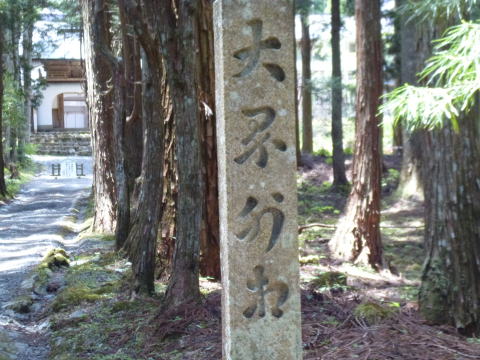
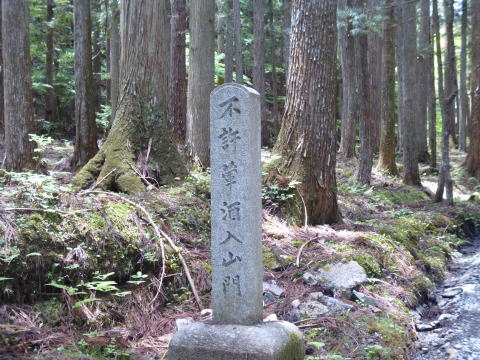
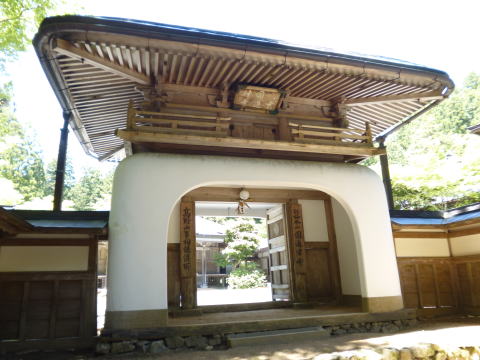
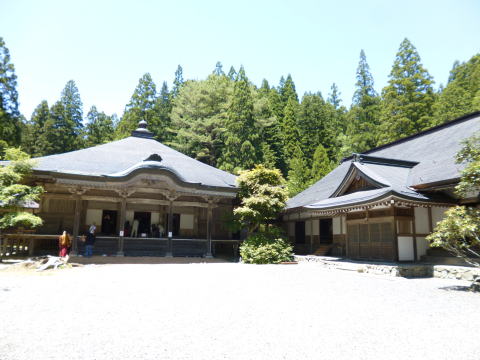
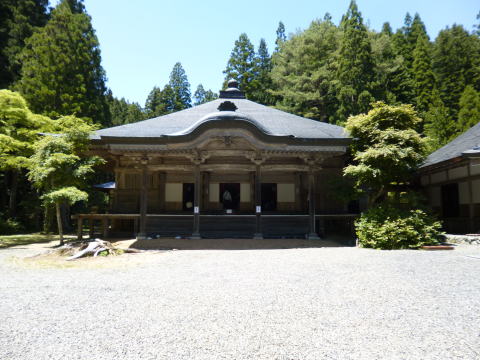
remains of the women's hall at Omineguchi ![]()
The remains of the Omineguchi Women's Hall are located to the east of Point 23 of Mount Koya's Women's Trail in Wakayama Prefecture.
The entrances to Mount Koya's sacred grounds are called the "Seven Entrances to Koya," and until the ban on women was lifted, women were not allowed beyond those entrances,
and at each entrance a women's hall was built as a secluded hall for women.
This is the remains of the women's hall at Omineguchi.
The pilgrimage route of about 59 km from Mount Omine to Mount Koya, passing
through Dorogawa and Tenkawa, was called the Omine Trail.
The information board at the site reads as follows:
The remains of the women's hall
There was a Godaison Hall here, and next to it was the women's hall at the east entrance (Yamatoguchi or Omineguchi).
The principal deities of the Godaison Hall are Acala, Daiitoku, Gozanze, Gundari, and Kongoyasha, and it stood at this location until the middle of the Meiji period.
Take the bus from Koyasan Station on the Nankai Koya Line, get off at Okunoin-mae bus stop, then walk for 30 minutes. 30 minutes walk from Nakanohashi Parking Lot.
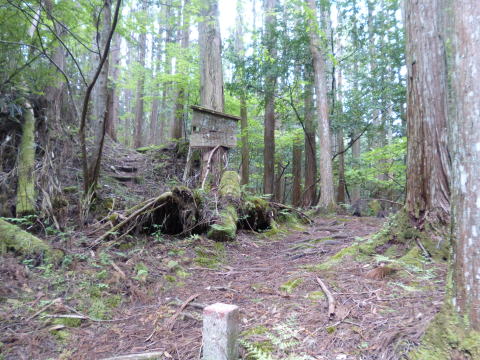
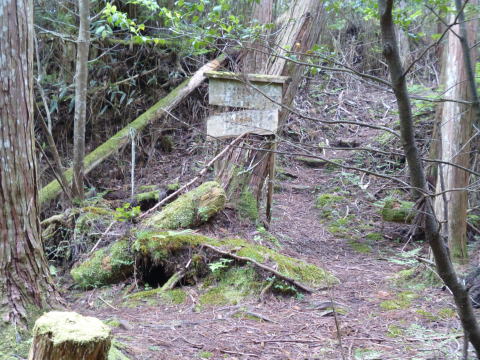
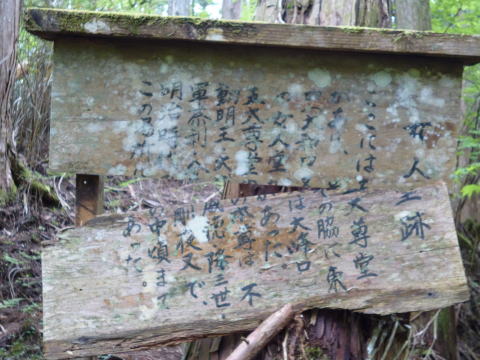
East Gate of the Seven Entrances to Koyasan ![]()
The East Gate of the Seven Entrances to Koyasan is located on the Women's
Path at Mount Koya in Wakayama Prefecture.
The information board on-site reads as follows:
East Gate
Also called the Yamato Gate or Omine Gate, it is a Shugendo trail that leads from Yoshino to Mount Koya, passing through Mount Omine, Dorogawa, and Tenkawa,
and it is also the trail that Kobo Daishi first entered Mount Koya.
The trail from Yoshino to Mount Koya is also known as "Kobo Daishi's Path" and the "Path to Discover Mount Koya."
A trail running event called "Kobo Trail" is held on the path.

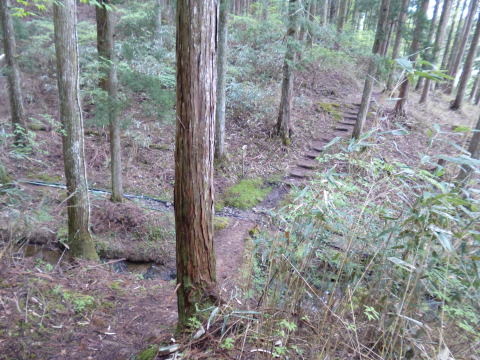
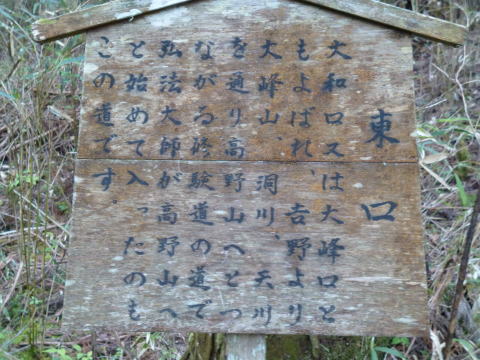
Omineguchi ![]()
Omineguchi is located on the south side of Nakanohashi Parking Lot at Mt.
Koya in Wakayama Prefecture.
The entrances to the sacred area of Mt. Koya are known as the "Seven Entrances to Koya," and Omineguchi is one of them.
The Kii Kuni Meisho Zue describes it as one of the seven climbing routes as follows:
Seven Climbing Routes: All seven entrances have a women's hall. Women are not allowed above the hall.
(Omitted)
Omineguchi: Also called the east entrance or the Nogawa entrance. Leads to Renkadani. Approximately 15 ri from Omine.
This route is the eastern entrance to the mountain, descending from the top of Mt. Omine to Dorogawa, passing Tenkawa and entering from Tenguki.
This route is commonly known as the seven and a half steps. It is said that if you make the pilgrimage this way once, you will achieve the merit of seven and a half steps.

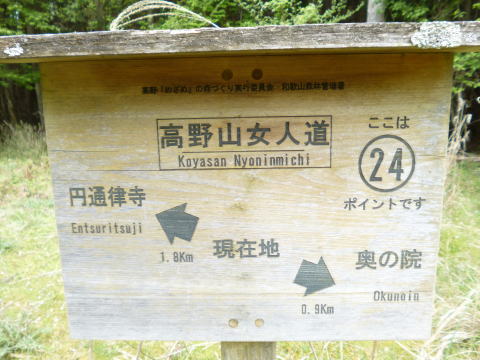
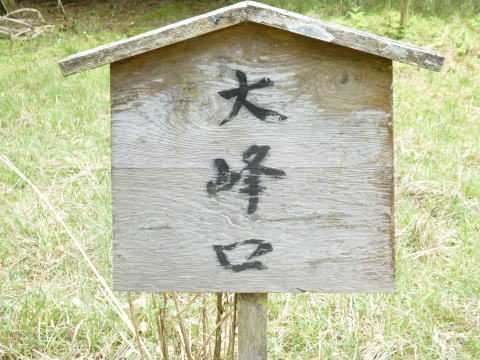
![]()
Okunoin is a cemetery and sacred area that extends about 2km from the Ichinohashi bridge to Kobo Daishi's mausoleum.
The path is lined on both sides by hundreds of centuries-old towering cedar
trees.
Among the trees are over 200,000 gravestones and memorial pagodas for people
ranging from important figures to commoners.
When we walk along the path of Okunoin, we can get peaceful mind with Japanese
ceder trees
Okunoin is a Buddhism Healing Forest.
In the prayer for the Manto-Mange-e ceremony in 832, Kobo Daishi wrote, "When the universe,
all living beings, and nirvana are exhausted, my wish then be fulfilled."
In other words, he made a great vow:
"As long as all living beings in the universe try to attain enlightenment, as long
as they try to become Buddas, as long as people keep seeking nirvana, I
will not finish my prayers.
There is writen stone sign of his vow on the left side of the path.
Every year on August 13th, Candle Festival (Rosoku Matsuri) is held on
the path.
100,000 candles are lit along the path in the precincts of Okunoin from
the Ichinohashi bridge to the Torodo (Lantern Hall).
From 8:00pm, a Buddhist memorial ceremony is held at the Torodo.
The best way to approach Okunoin is to take the bus from Koyasan station
to Ichinohashimaebus stop.
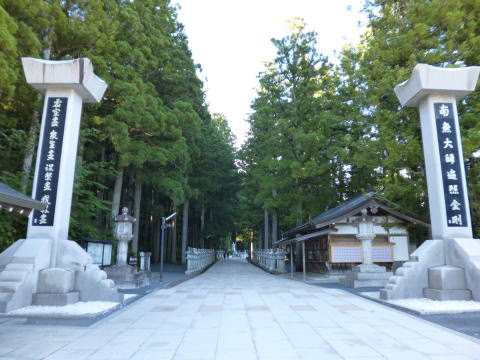

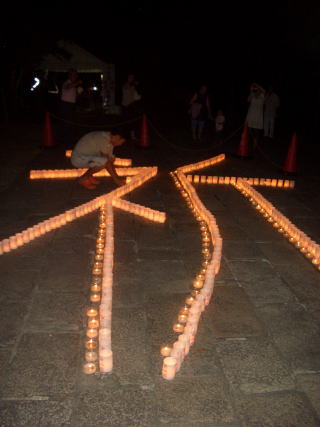
Mount Mani (Manisan) ![]()
Mount Mani (1,004m) is located in Koya town, Wakayama Prefecture.
It is one of the three mountains of Koya, along with Mount Yoryusan (1,008.6m) and Mount Tenjyokusan (915.0m), and is located northeast of Okunoin Gobyo.
According to the Koyasan Secret Records, this is one of the peaks to the east, west, north and south where Kobo Daishi buried a copy of the flying sanko, and it is said that he enshrined the jewel here.
There is a shrine on the mountain where a statue of Nyoirin Kannon is enshrined.
Take the bus from Koyasan Station on the Nankai Koya Line, get off at Okunoin-mae
stop, and walk for an hour along the Women Pilgrimage Route.
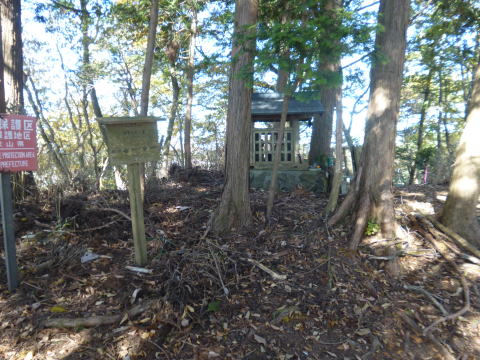
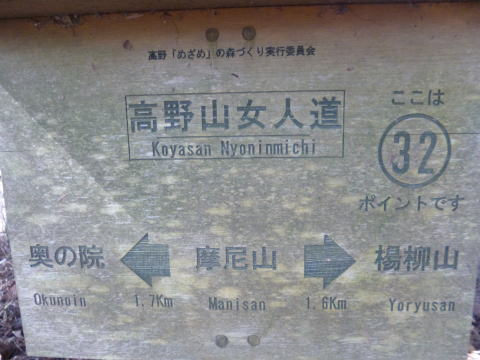
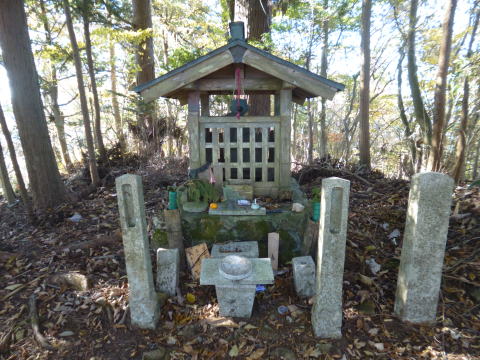
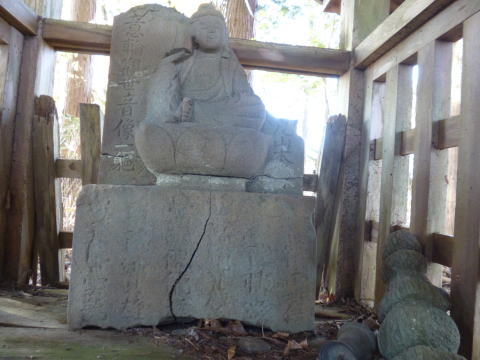
Mount Yoryu (Yoryusan) ![]()
Mount Yoryu (Yoryusan) (1,008.6m) is located in Koya town, Wakayama Prefecture.
It is one of the three mountains of Koya, along with Manisan (1,004m) and Tenjyokusan (915.0m), and is located north of Okunoin Gobyo.
At the summit, there is a small shrine where a half-seated statue of Yoryukannon
is enshrined, with an inscription dated March 21, 1771 (Meiwa 8).
Yoryukannon is one of the 33 Kannon, and is said to be the same entity
as Bhaisajyaguru (Medicine King) Kannon, whose main vow is to eradicate
various illnesses and misfortunes.
According to Buddhist scriptures, one should hold a willow branch in one's right hand and place the left hand on one's left breast.
There is an information board about the Yoryusan Educational Exhibition Forest.
Take a bus from Koyasan Station on the Nankai Koya Line, get off in front
of Okunoin, and walk for two hours along the Women Pilgrimage Route.


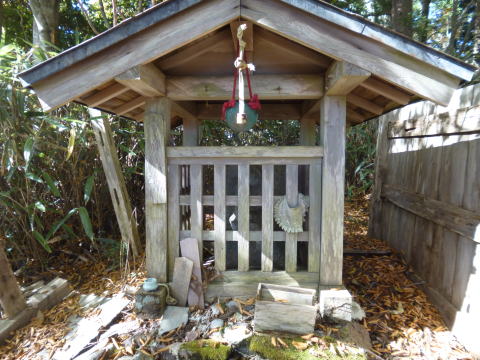
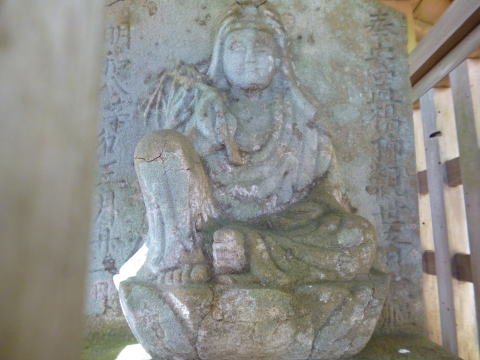
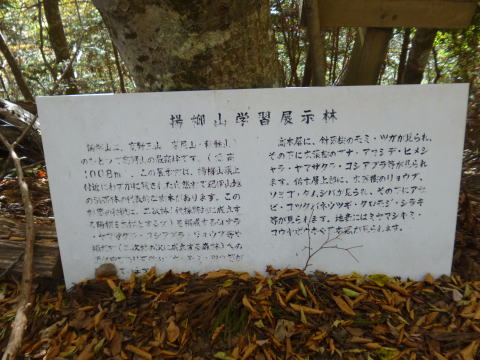
Mount Tenjiku (Tenjakusan) ![]()
Mount Tenjiku (Tenjakusan) is located in Koya town, Wakayama Prefecture.
It is one of the "eight leaves within Mount Koya" (Mt. Koya,
Mt. Mani, Mt. Yauryu, Mt. Tenjaku, Shotogamine, Kongorei, Sannourei, Henjourei).
It is 915m above sea level, and there is a shrine to Maitreya Bodhisattva on the peak.
The Kii Shoku Fudoki Volume 2 states the following:
〇Tenjakusan
It is on the peak of Hitsujisaru (southwest) in the temple hall, and there
is a small shrine to Maitreya at the top, about five or six cho (540-650
m) away.
It is said that Kobo Daishi buried the sword of Acala (treasured sword) on Tenjakusan, and the sutra Rishukyo was also buried there, but it had decayed and only the gilt bronze scroll remained, which is said to be the origin of the name.
Take the bus from Koyasan Station on the Nankai Koya Line, get off at Okunoin-mae stop, then walk for about 30 minutes.
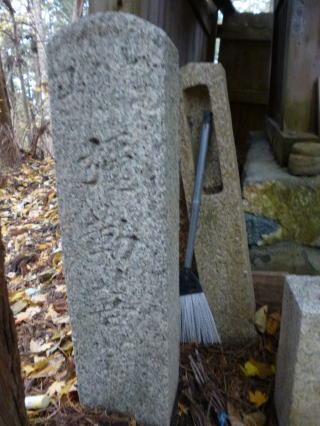
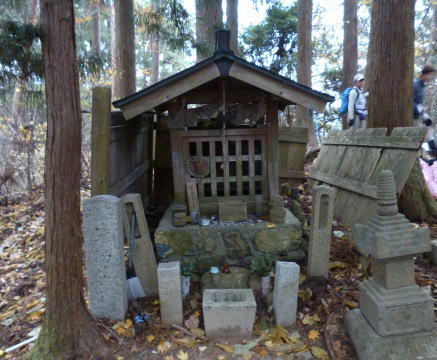


remains of the Kurokoguchi Women's Hall ![]()
The remains of the Kurokoguchi Women's Hall are located in Koya town, Wakayama
Prefecture.
Kurokomichi is one of the Koyasan pilgrimage routes in Ito District, Wakayama Prefecture, and runs from Kashikodo in Hashimoto City to Kurokoguchi, one of the seven entrances to Koyasan, in Senjuin Valley at Koyasan.
The entry for Kurokomura in the Kii Shoku Fudoki states that "Kuroko
means a dark valley and narrow valley."
It was considered a shortcut from Hashimoto to Koyasan, and was also called
Yamatoguchi because it was often used by pilgrims from Yamato (Nara Pref.).
The Kurokoguchi Women's Hall was one of the women's halls at the seven entrances to Koyasan, and a wooden signboard has now been erected on the site.
Take the bus from Koyasan Station on the Nankai Koya Line to the Koyasan Police Station stop, and walk for 5 minutes.

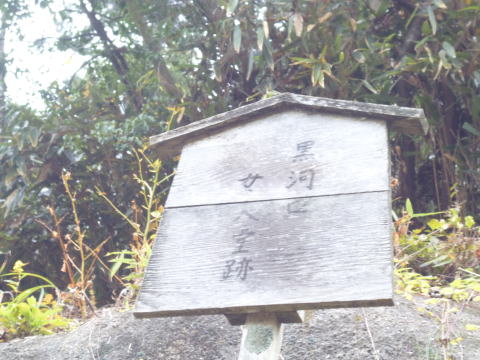
TOP PAGE 観光カレンダー
TOP PAGE 观光最佳时期